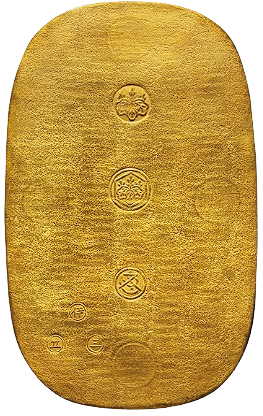Tenpō Ōban Kin
(元禄大判金)


(Ginza Coins Collection, Tokyo. Reproduction authorized. © All rights reserved.)
At the end of the Bunsei era, Japan was facing a growing economic and political crisis, which worsened with the beginning of the Tenpō era (1830–1844). This period was marked by economic instability, natural disasters, and the Great Tenpō Famine (1833–1834), which led to a sharp rise in rice prices and severely affected the Tokugawa government and the daimyō. In 1831, a revolt of over 60,000 peasants in the Chōshū domain reflected rising social unrest and foreshadowed the movements that would lead to the Meiji Restoration. In response to the crisis, the government introduced the Tenpō Ōban Kin in 1838, a new gold coin minted by Gotō Hōjō, inspired by Kyoho models but enriched with distinctive features. A total of 1,887 specimens were produced, and the coin remained in circulation until 1860, representing a significant attempt to strengthen the economy and a key moment in the monetary history of feudal Japan.
| Coin Name | Tenpō Ōban Kin |
| Japanese Inscription | 天保大判金 |
| Historical Period | Edo Period (1603 – 1868 d.C.) |
| Year of Minting | 1838 – 1860 d.C. |
| Chronological Reference | Japan |
| Minting Location | Edo, Kyoto |
| Issuing Authority | Clan Tokugawa (Tokugawa Ieyoshi) |
| Function | Officially minted Valore 10 Ryō |
| Material | Oro (67.4 %) Argento (32.6 %) |
| Shape | Elongated oval |
| Height | 15.8 cm |
| Width | 9.6 cm |
| Weight | 165 g |
| Manufacturing Technique | Manual casting and hammering |
| Obverse Text and Symbols | Gosan Kiri seal inscribed in a circle Inscription Jū Ryō 壹両 (10 Ryō using Daiji-style numerals) Mint official's signature: Ōbanza Gotō Gotō Hōjō (後藤芳乗) |
| Reverse Text and Symbols | Free Gosan Kiri seal Gosan Kiri seal inscribed in a rhombus and in a circle Kao in form (Jishin Horitsuke Ban) * Gokuin producer seals |
| Calligrapher / Artist: | Gotō Hōjō |
| Museum References | Currency Museum Bank of Japan ⅡAエドa 29/6 |
| Number of Known Specimens | Very rare; 1,887 known specimens. |
Sources and Bibliography
The Gold of Tokugawa, Alberto Rolfini 2025
瀧澤武雄, 貨幣 Takizawa Takeo, Kahei Nipponshi sho Hyakka 1999
